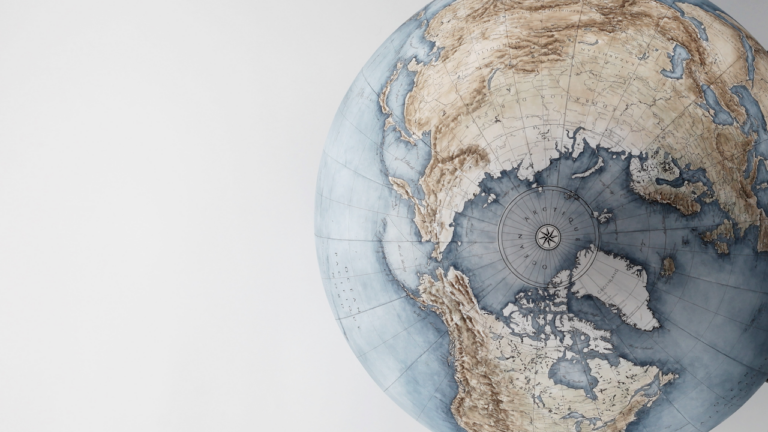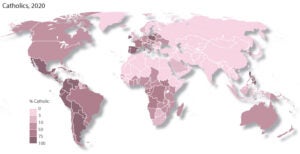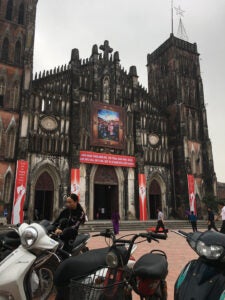
Global Christianity: the Future of the Catholic Church
In February 2022, the Vatican released statistics showing that in 2020 the number of Catholics in the world increased by 16 million to 1.36 billion.
That means that 17.7% of the world’s population is Catholic. Of this total, 48% are in the Americas, with 28% living in South America. Following recent trends, the Catholic Church grew most rapidly in Asia (+1.8%) and Africa (+2.1%) with very slight growth in Europe (0.3%).
Statistical snapshots
The figures show many things — including a serious mismatch in how Catholic priests are allocated around the world.
Worldwide, the number of Catholics per priest rose from 3,245 in 2019 to 3,314 in 2020. But more than 50% of priests live and minister in the global North — while more than two-thirds of Catholics live someplace else. While 236 million Africans are Catholics, the U.S. and Canada are home to 84 million Catholics — but these two countries have almost the same number of priests as the whole of Africa. The Catholic Church in the U.S. has historically been served by priests from elsewhere — including Ireland, Poland, Italy — to support its first and second generation immigrant members. Now, the Catholic Church in the global North is significantly supported by priests and religious who come from countries in the global South.
In Europe, on average, there is one priest for 1,746 Catholics and church attendance is low. In Africa, far more Catholics attend church regularly but there is one priest for every 5,089 Catholics. At the end of 2020, there were a total of 410,219 Catholic priests, a decrease of 4,117 since 2019. The number of priests in North America and Europe continued to decline, but Africa and Asia saw a significant increase.
A similar pattern can be observed among women religious, whose numbers declined by 1.7% across the world from 630,099 in 2019 to 619,546 in 2020. Africa and Asia saw numbers rise (3.2%) as did Asia (0.2%), while numbers fell in Europe (-4.1%) and the Americas (-2.8%). There was also a significant fall of 5.7% in Oceania.
These days, new vocations to religious life and priesthood come disproportionately from Africa and Asia. Those two continents now provide 60 percent of all seminarians worldwide.
The Church in the global North is now being significantly supported by priests and religious who come from countries in the global South where their ministry is needed. If the Church in the U.S. had to kick out all the priests and religious women from Latin and Central America, Asia and Africa who serve here, the doors of many of our parishes, Catholic schools and social ministries would have to close.
Growth and decline — new patterns
Overall, the Catholic Church kept pace with global population growth but did not outstrip it.
Viewed from the West, it’s easy to conclude that the Church is shrinking. In Western Europe and parts of the U.S., parishes are closing and consolidating. It is also unclear what effect the Covid-19 Pandemic has had on church attendance, but we are unlikely to witness a lasting bounce back in attendance. Formal religious affiliation and commitment, along with being an active member of a parish, are all declining.
Yet from 267 million Catholics in 1900 to 1.05 billion in 2000 and 1.36 billion today, the Catholic Church has expanded more through the last 100 years than any time in its 2,000 years of existence. The 16 million new Catholics of 2020 is more than the entire Catholic population of Canada. In other words, the global Catholic story is not one of steady decline, but rather rapid growth.
Through the last 100 years the Catholic Church has expanded more than any time in its 2,000 years of existence.”

Where and who the Church is
The vast majority of that growth is outside the western hemisphere. Catholics have moved from being strongly concentrated in a few, important countries, to being a significant minority in what is now a religiously plural world. In most wealthier countries, where secularization is increasing, specific religious affiliation and formal religious practice is diminishing. Christianity is becoming more of a social memory than a major factor in public life.
Most of today’s Catholics do not live in Europe, or the global North. By 2050, 75% of Catholics will live outside the west. Catholicism, which was born in the Middle East, is — at least at the grassroots — a non-Western religion, and it will be increasingly more so as time wears on. The share of the world’s Catholics who live in Africa has increased from 1.9 million in 1900 to an estimated 236 million today. That’s fully 20% of the Church. While the population of Africa increased from 1950 to 2000 by 313%, the Catholic population increased by 708%. In terms of median age, Africa is a young church — and looks to be the center of its future.
The share of the world’s Catholics who live in Africa has increased from 1.9 million in 1900 to an estimated 236 million today.”
Across Asia, Catholicism continues to be a minority faith. But Asia’s total population is so large, it is now home to one in ten Catholics. Latin America has undergone a population explosion — but in this traditionally Catholic continent, the Church has undergone retrenchment over the last few decades. Brazil, for example, is now home to the world’s second biggest Protestant population and will soon become minority Catholic. Central American nations are following the same trend of moving towards Evangelical churches, or becoming more secular.
Africa is a young church — and looks to be the center of its future.”
For more than a thousand years, Catholicism’s thought patterns and structures have shaped and been shaped by different variations of Western civilization: Irish, French, Spanish, Portuguese, Italian and German. In many of those societies, the Catholic Church historically enjoyed a privileged relationship with the state. Even with the spread of Catholicism to the “New World,” its thought has tended to remain rooted in those European cultures where Catholics have been a majority. But the majority of today’s Church is no longer located in Europe, or the global North. And for the more than 80% of Catholics who live in the poorer economies of the world, people’s daily concerns and their outlook on life are going to be very different from the countries of the global North. These are countries with younger populations — and also places where human dignity is most threatened.
The global Catholic story is not one of steady decline, but rather rapid growth.”
Globalization
Globalization inevitably affects religion. The world has seen unparalleled economic growth and countries are now interdependent as never before. At the same time, wealth is becoming more concentrated in the hands of the wealthiest: 25% of the world lives without sufficient means for survival. Wars and economic difficulties have brought about massive shifts of peoples. Significant immigrant populations are bolstering Europe’s falling birth rate. For example, a significant proportion of kindergarteners in Paris are Muslim, but first-generation immigrants are also African and Asian. The U.S. Catholic Church has been boosted by immigrants and refugees from Asia and Latin America — with the result that it matches the diversity of the whole of American society.
The worldwide entertainment industry also channels secular materialism. In reaction to the pressures of globalization on traditional cultures, religious and nationalistic fundamentalism has thrived.”

While the global population has increased, the communications revolution has shrunk the world. People in Nairobi, Seoul and La Paz listen to the same music, and see the same movies. Yet the worldwide entertainment industry also channels secular materialism, subtly or blatantly. In reaction to the pressures of globalization on traditional cultures, religious and nationalistic fundamentalism has thrived.
The global Catholic Church inhabits those same realities.
Unity and Diversity
Vatican II was the first ecumenical council to be truly international in its membership and global in its worldview. One of the four constitutions resulting from Vatican II, Gaudium et spes, discussed at length the relationship between Church and culture in the modern world. It taught that the Church must take on a variety of cultural forms if it’s to fulfill its mission of proclaiming the Gospel meaningfully.
Catholicism was always culturally diverse: the Christians of the first generation included freemen and slaves, Greeks and Jews. The history of the Catholic Church shows that there was always diversity in belief and practice. But through time, the Church came increasingly to stress unity in both its governance, discipline and theology. The strong, centralized papacy of the second millennium was an attempt to repulse domination by political powerful leaders and state. The reforms of the Council of Trent set Catholic life somewhat in stone for almost 500 years, and the Catholicism initially exported to the Americas and Asia was of a uniform, Eurocentric style – even though over the centuries it took on a vibrant palette of local colors, developing a rich range of expressions and traditions that grew organically out of the histories, experiences and cultures of the places where it took root.
The Church is always experienced in local languages and ways of thinking, yet it cannot be identified with any one single way of life, other than the way of Jesus.
Jesus is always “the light of the world” and his Gospel is never to be fully identified with any one culture. However, in order for the Catholic faith to reach hearts and minds, the Gospel needs to be presented in a way to which people can relate.
In order for the Catholic faith to reach hearts and minds, the Gospel needs to be presented in a way to which people can relate.”
This involves a process of expressing the life of the Church in local customs and habits of thought — what we now call by the modern term inculturation. This process has existed since the beginning of Christianity, at the grassroots level as well as through the work of missionaries.
Since Vatican II promulgated the translation of the liturgy into local languages, liturgy above all has been where the Church has most developed a consciously inculturated Catholicism expressed in music, symbols and rituals.
Yet some theologians have argued that inculturation needs to go far deeper and that the whole of Church life, say in South Asia or West Africa, should take on a local complexion – even including doctrine and Church discipline.
For example, in Africa, where celibacy is an anti-value, it could make pastoral sense not to insist on priestly celibacy.
In India, celibacy is not an issue but the relationship of the Christian Gospel to Indian religions is. In many Asian cultures, Catholicism is still widely perceived as foreign and, in some countries — such as India and China — the Catholic Church is persecuted. Historically, evangelization in Asia has sometimes raised tensions in the Church. The attempts by Jesuits in China and India to create a synthesis between local cultures and Christianity in the 17th and 18th were roundly criticized in Europe and eventually forbidden. Likewise, contemporary Asian theologians who have asserted that salvation may be found in other religions have clashed with the Vatican’s Congregation for the Doctrine of the Faith.
The bishops who gathered in Rome in 1998 for the Asian Synod protested what they saw as the Eurocentric focus of the initial discussion document, which tended to see power as being devolved from Rome to the world’s dioceses. Vatican II stresses that the fullness of the Church is present anywhere there is a bishop, priests and people. What has been more problematic is the autonomy of a diocese or a group of dioceses. A totally centralized administration cannot meaningfully respond to all the Church’s needs. How much should Vatican officials dictate the pastoral practices of people who live thousands of miles away, when they do not know the country or the people, their history or way of life?
The Church in Asia, the Asian bishops argued, will only advance if it is Asian in spirit and life. Asian Catholicism will flourish in a threefold encounter, involving sharing life with all of Asia’s inhabitants (especially the poor), engaging with local cultures, and dialoguing with Asia’s majority faiths of Buddhism, Islam and Hinduism. The proposal of Asian bishops for dialogue suggests patient evangelization through example and cultivating friendship with people who are religiously different, rather than rushing to convince them of the truth of Christianity.
But there is an important question that emerges from engaging with local cultures through intentional attempts at inculturated diversity. How far can you go, say in using Hindu terms to describe Christian beliefs before you end up with what is effectively another form of Hinduism into which Catholicism has been co-opted? Any truly inculturated Catholicism has to remain in union with the whole Church. Maintaining unity involves distinguishing between what is essential and what is not.
It also demands listening respectfully and looking for good examples. The global Catholic Church might learn from particular countries in Africa, whose borders were defined artificially by colonialism, or whole regions across Oceania that contain huge linguistic, cultural and religious differences. The communion forged in such places might shape the future unity of the whole Church — between conservatives and liberals, laity and clergy, women and men, rich and poor. The Amazonian Synod raised some questions about the limits of inculturation and the Synod on Synodality may well shed light on what we mean by unity.
Returning to the Source
The Church is one — Holy, Catholic and Apostolic. Unity is balanced by a tension with diversity — a Catholicity — that seeks to unite diverse ways of being together in a dynamic and creative tension. Holiness and apostolicity are aspects of the same reality: the more the life of the Church is holy, the more it will be effective in its mission to “make disciples of all nations.” Evangelization involves “gospeling” the earth, an impossible task unless the Church simultaneously “earths the Gospel,” which should always be done remembering that God is not absent from any human experience that is not sin. Christ is already present in the Church of the future – and coming to meet us.
The first Christians “devoted themselves to the teaching of the apostles and to the communal life, to the breaking of the bread and to the prayers” (Acts 2:42). The center of all Catholic life is Jesus Christ, “the same yesterday, today, and forever” (Heb 13:8), yet the seed of faith needs to be planted in good soil if it is to yield a harvest. Evangelization involves the business of showing faith at work as well as telling others about it.
The Church is communal life, or it is not Church. The universal call to holiness of Vatican II was not a reaction to declining numbers of priests and religious, but arose from the conviction that in the body of Christ, all parts are co-responsible. The growth of the Church in Africa and Asia has been accomplished with a significantly lower priest-to-people ratio than exists in the global north. Church life cannot happen without the real ministry of lay people. This demands re-casting the relationships between the clergy and laity – including women’s roles as missionary disciples.
The (Catholic) Church is also part of the community of humanity: when it lives and loves well, it can be a beacon of hope for all. With its global reach, Catholicism is uniquely poised to offer a voice that can shape public debate and policy in favor of the underprivileged of all places.”
The cultures of many poorer countries stress community — an emphasis that is a very healthy corrective to Western individualism and what Pope Francis has called “ideological colonialism” in which Western viewpoints are imposed on cultures with very different ways of thinking and living. The global challenge is to build a Catholic Church that balances centralized authority with subsidiarity and autonomy, and improving communication so that we don’t end up with any one part of the Church being individualistic. The church in Germany, for example, has always been willing to share human and financial resources, given its financial strength. It’s also dominated Catholic thinking for some 150 years. What is not clear is whether Catholicism will survive numerically and financially, given the current loss of membership, or whether it is willing to receive as well as to give and listen to voices that are radically different from its current stances.
The community of the Church is also part of the community of humanity: when it lives and loves well, it serves as a beacon of hope for all. With its global reach, Catholicism is uniquely poised to offer a voice that can shape public debate and policy in favor of the underprivileged of all places.
With its global reach, Catholicism is uniquely poised to offer a voice that can shape public debate and policy in favor of the underprivileged of all places.”
A Catholic Church that is primarily poor and young will also call for a reintegration of the communal aspect of faith. The Enlightenment separated out spiritual experience into the realm of the individual. For people who describe themselves as “spiritual but not religious,” an organized religion such as Catholicism is perceived to be irrelevant to spiritual growth. But many Catholics, especially those living in poverty, are unlikely to make sense of that phrase. Rather, they find protection, dignity and meaning in their Catholic faith. The voices of the poor, marginalized and disenfranchised are eloquently calling for those better off to rethink what it is to be fully human and fully Christian – and then to follow through with what we come to understand.
Editor’s note: This post was adapted from a presentation in March 2022 by former IACS President Rev. Dorian Llywelyn, S.J. at the USC Caruso Catholic Center.